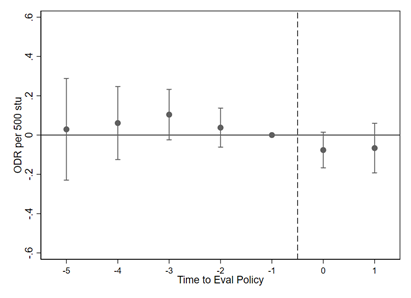The Effects of Higher-Stakes Teacher Evaluation on Office Disciplinary Referrals
David Liebowitz, Lorna Porter & Dylan Bragg
Discussions about teacher evaluation often focus on how evaluations can inform high-stakes job decisions. However, when designing teacher evaluation frameworks, policy makers and system leaders also explicitly seek to promote the development of teachers’ pedagogical skills. One clear emphasis in most measures of teacher practice is that teachers develop a safe and supportive classroom learning environment. Thus, as intended, introducing more intensive teacher evaluation practices could decrease the rate at which teachers send students to the office for misbehavior. This might happen if, through the cycle of observations and feedback, teachers’ classroom management skills improve and they are better equipped to minimize student misbehavior. In contrast, unintentionally, higher-stakes teacher evaluation policies could increase the rate at which teachers send students to the office for misbehavior. For example, if teachers are stressed about how orderly their classroom seems during an unannounced observation, they might send more students out of class in the hopes that fewer disruptions occur during an evaluative visit. They might also send disruptive students out if they perceive that doing so will maximize the learning environment for their other students.
In this study, we tested whether higher-accountability teacher evaluation polices, implemented in response to the 2009 Race to the Top competition, affected how teachers responded to classroom misbehavior in the form of Office Disciplinary Referrals (ODRs). We examined this question using a sample of 2,564 schools, all of which were attempting to implement the Positive Behavioral Interventions and Supports (PBIS) framework throughout the 12 years of our sample.
We found that higher-stakes teacher evaluation neither led to a significant increase, nor decrease, in the overall rate of Office Disciplinary Referrals (see figure). Our findings are consistent across grades subject to high-stakes testing (where pressure on teachers may be higher) compared to grades not subject to high-stakes testing, and among schools with different initial disciplinary climates.
Our results suggest that teacher accountability policies, either on their own or coupled with well-implemented systems to promote positive behavior, are not sufficient to limit students’ entry into the disciplinary pipeline. Our results also suggest that pressures introduced by higher-stakes evaluation policy did not lead to the unintended consequence of teachers removing students from the classroom at higher rates.
One implication of our findings may be that if future reforms to teacher evaluation systems are to directly affect teacher practices in the classroom, they may need to address implementation more explicitly.

What does this show? This figure shows the estimated effect of higher-stakes teacher evaluation policy on the rate at which students are removed from the classroom for misbehavior (Office Disciplinary Referrals, or ODR), per-500 students per-day. Each point represents the estimated effect for the year relative to when states implemented higher-stakes teacher evaluation policy reforms (Time to Eval Policy) and the bars extending above and below the point represent the 95% confidence interval—a measure of how precise the estimate is. Year 0 represents the first year in which states implemented higher-stakes evaluation.
Full Article Citation:
Liebowitz, D., Porter, L., Bragg, D. (2022). The effects of higher-stakes teacher evaluation on office disciplinary referrals. Journal of Research on Educational Effectiveness. DOI: https://doi.org/10.1080/19345747.2021.2015496.
